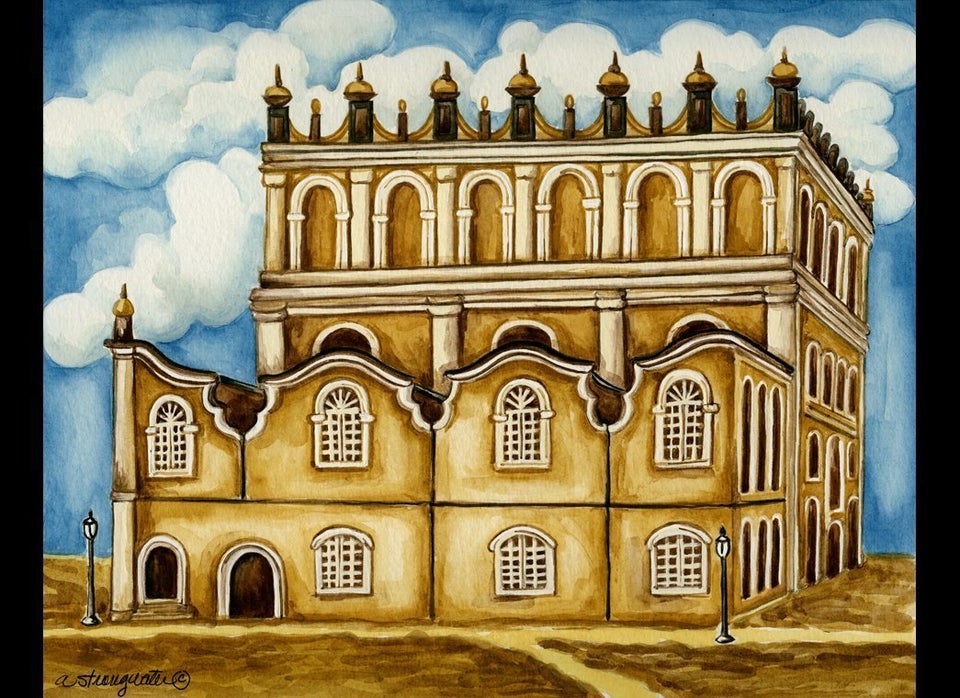"Lost Synagogues? They are lost only if we forget. How can we even begin to discuss what was lost until we know what was before. Strongwater's paintings evoke the beauty and vitality of the lost communities of Europe."
--Stephen M. Goldman, Executive Director, Holocaust Memorial Center, Michigan's Holocaust Museum
World War II saw the destruction of 6 million Jews, their lives, their homes, their organizations, institutions and thousands of synagogues. What did 6 million Jews support? What did the European Jewish world look like before the Third Reich? In my project I re-create in paintings and words synagogues that were destroyed in the process of ridding Europe of its Jews. I am telling a part of Jewish history that I have missed hearing: what came before the war. It's a way for me to connect the dots.
My mother's family came to the U.S. from Poland in 1926. My grandfather had packed a bag several times in the early 1920s and gone in search of a better place to be a Jew. He decided that America was the only safe place even if it wasn't necessarily the most sympathetic. As the head of a large family and one of many siblings, he helped get everyone here to the USA. As soon as he could, he obtained citizenship and passports for everyone. He sent those passports to Europe to be doctored and used to get more Jews out. He worked hard to establish Israel and cherished the photo he had of himself with David Ben Gurion. He and the rest of my mother's family were very active in helping refugees before, during and after the war, here in the U.S. and elsewhere. My mother was a regional vice president of Women's American ORT and there is even a school somewhere in Israel with my father's name on the wall. It always seemed important to me to make a contribution.
When my grandmother died, Sarah, a very glamorous German Jewish woman came into my grandfather's life. She looked him up when she found out my grandmother died. Although she didn't discuss it very much, she told me that the only reason she survived the war was that my grandfather supported her and her sons in hiding and that he did that for many people. I never got more details but that was normal in the 1950s and '60s. We sang Hatikvah (Israel's national anthem) when we lit the Hanukah candles -- the menorah had a music box in the base -- and my grandfather cried as he always did when emotions got the better of him. We spent every Sabbath at my grandparent's tiny house in the Bronx, New York, where many of his siblings came to discuss politics, art and Israel. My friends asked each other if we were Jews first or Americans first. We watched Gertrude Berg on TV and my grandmother actually talked to her neighbor through their kitchen windows, just like Molly Goldberg.
The father of the boy who sat next to me in high school wrote "Fiddler on the Roof," which my grandfather insisted we all see as he, like one of the characters, was the first in his neighborhood in Poland to get a sewing machine. We used William L. Shirer's "Rise and Fall of the Third Reich" to learn the story of WWII. My mother and I always agreed that the horror of the war made it impossible to think. All we could do was cry. So how do you tell the story? And how account for the sophistication of my multi-lingual, world-traveling grandparents?
For me this project illuminates what came before the war -- something that was not talked about much when I was younger. I understand the pain that made that a reality but as time has gone on and I learn more, I think we should all know more about what we created and maintained.
I tell the story in a visceral way that speaks through pictures and the accretion of small details. One synagogue after another, some very similar in architectural style, each story having some unique aspect. One synagogue hosted Zionist meetings, another was the first Reform synagogue with an organ and was paid for by a court Jew, another had an organ that was never used on the Sabbath. Jews arrived in these places as early as the Roman Legions in the first century A.D. The synagogues served as centers of Jewish life not just to pray but also to hear the latest gossip or a lecture, see art, hear concert music and of course hold weddings, bar mitzvahs, holiday and ritual events of Jewish life. All the synagogues in my project were totally erased. That fact states the reality of the Holocaust, although I have chosen not to delve into the details.
My strength is in visual art -- communicating through pictures. Using archival photos as reference material, I have created more than 100 paintings that form the basis of a series of children's books that illustrate synagogues lost across Europe. The project will soon expand to cover synagogues in North Africa, Arab countries and Israel around the time of the establishment of the State of Israel. The work will also be presented in a coffee table book with expanded text and the photos I work from, a traveling exhibit of the paintings and lectures.
I present through my paintings the glory of what existed before the Holocaust.
Visit EifrigPublishing.com and astrongwaterdesigns.com for additional information. Or contact andrea@astrongwater.com.
